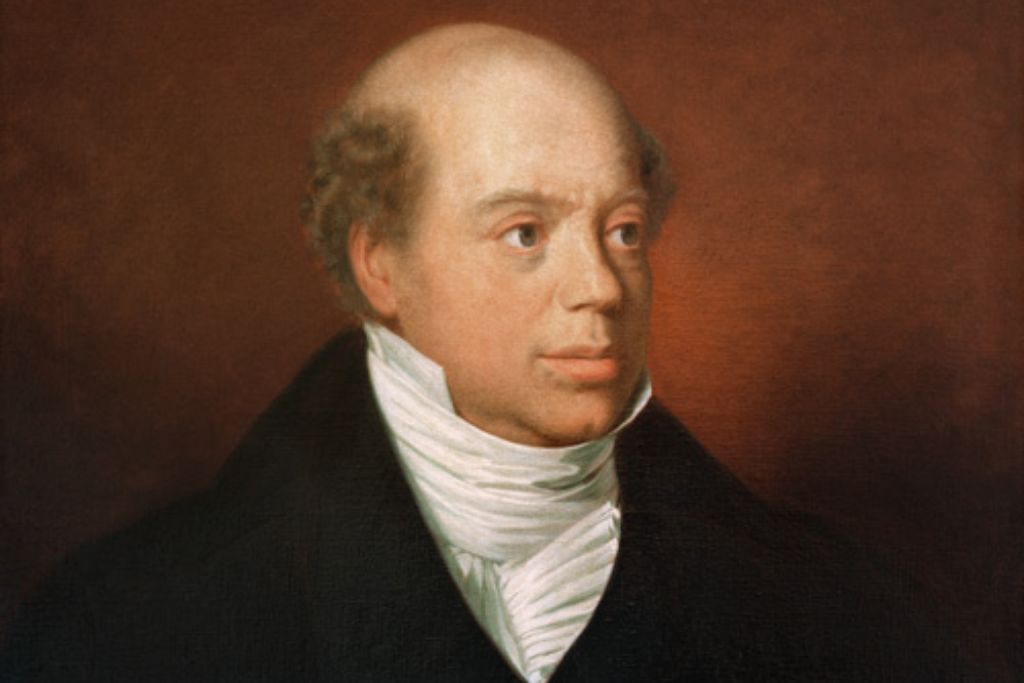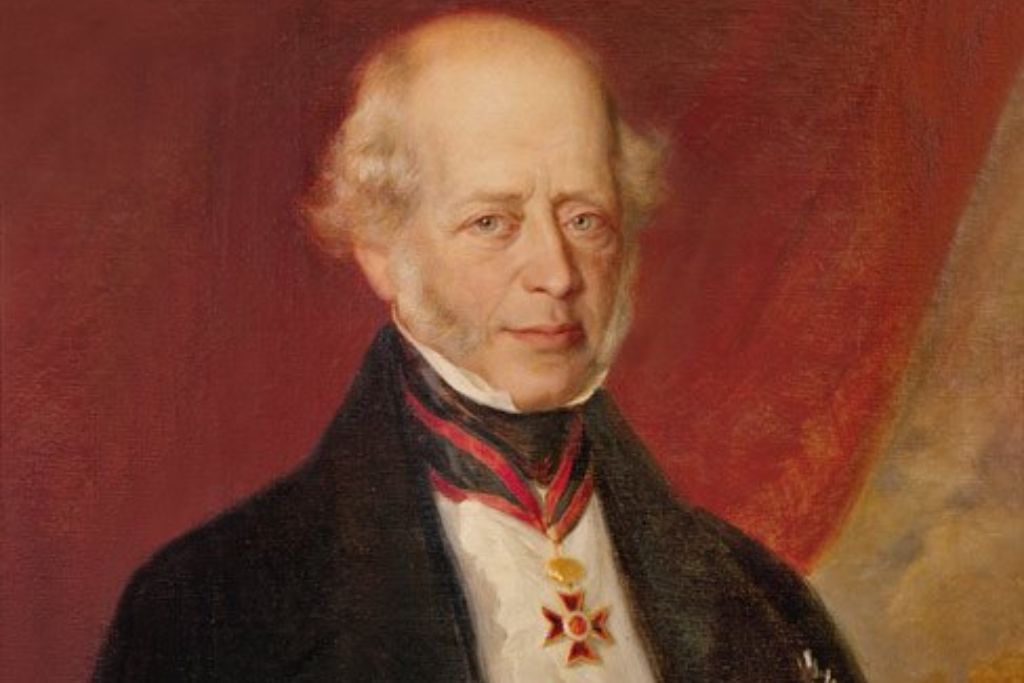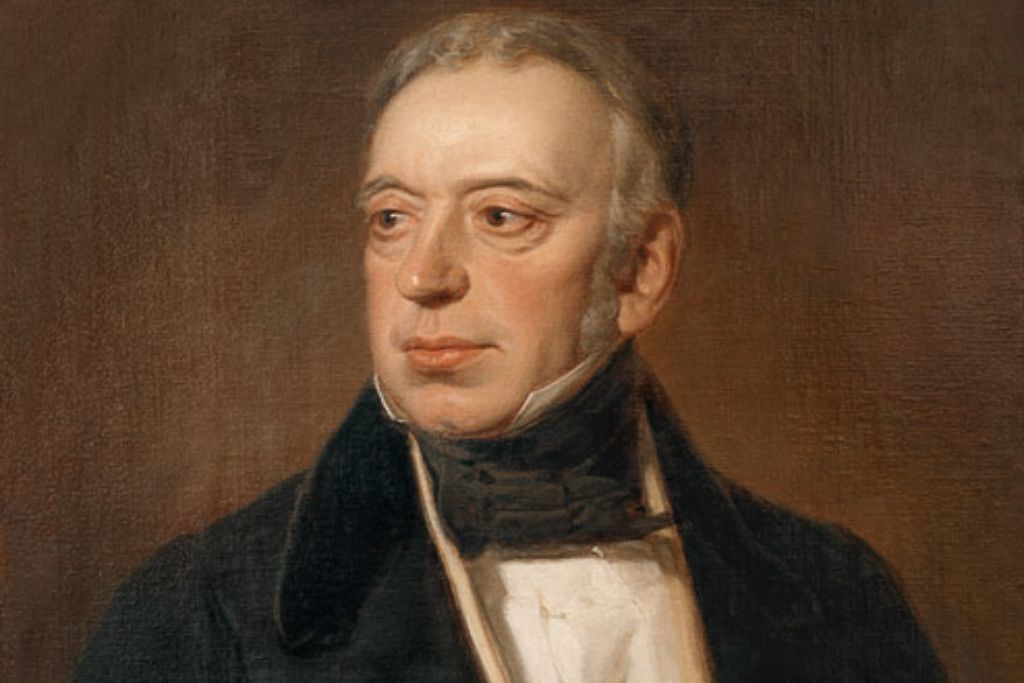
Today, the Rothschild family is famous for being among the world’s richest families. Whilst most members have been undeniably wealthy, by far the wealthiest was Nathan Mayer Rothschild, who founded the British branch of the family!
At the time of his death in 1836, Nathan Mayer Rothschild was the richest man in the world, with a personal net worth that was equivalent to 0.62% of the British national income at the time, or roughly $250 billion in today’s money…
Birth And Early Life
Nathan Mayer Rothschild was born on September 16 1777, as the fourth child (and third son) to German Jewish banker Mayer Amschel Rothschild and his wife, Guttle Schnapper Rothschild in the Frankfurt Ghetto, where all of Frankfurt’s Jews lived.
At the time of Nathan’s birth, Mayer was one of Europe’s preeminent bankers, having been raised as the Prince of Hesse’s court Jew (or Hoffaktor in German) which essentially saw him manage the prince’s estate on his behalf.
Growing up, Nathan had four other brothers (as well as five sisters). Following Jewish banking tradition at the time, Mayer ensured that all five of his sons were educated on how to become a successful European banker and money lender.
Whilst unbeknownst to Nathan and his siblings at the time, Mayer had a dream. Mayer’s dream was that one day, his five sons would go to the five major European capitals and establish themselves as prominent bankers.
Here, the five Rothschild siblings would then work in tandem with one another, loaning the various European monarchs all the money they needed for their many wars, whilst netting a sizable profit in the meantime.
Mayer revealed this to his sons when Nathan was in his late teens, describing his five sons to be arrows. Alone, they could easily be broken, whilst together, they were almost impossible to break, letting his sons in on his dream.
It was here, where Mayer designated the European capital each of his sons would move to. His oldest would stay in Frankfurt, his second oldest to Vienna, Nathan to London, his fourth son to Naples and his fifth son to Paris.
Moving to England
To that end, Nathan Mayer Rothschild would move to the British industrial city of Manchester in 1798, at the age of 21. Upon arriving in Manchester, Nathan took swiftly to learning English, whilst establishing a textile business in the heart of the city.
However, Nathan soon realized that Manchester had little to offer in the way of banking (as Nathan had hoped to go to a smaller city than London to establish his empire, before moving it to London to compete with established banking houses).
Following this realization, Nathan Mayer Rothschild would soon leave Manchester for London in 1804, as his father had initially intended. Soon after arriving in London, Nathan would begin trading on the London Stock Exchange (LSE).
As a trader, Nathan would buy and sell stocks, bonds and other financial instruments over the counter at the LSE. Nathan proved to be quite adept at this, netting a small fortune within a year of trading.
Building on this success, Nathan would open his own bank in 1805, where he’d continue to trade on the LSE, but also begin trading in foreign bills, British government securities and bills of exchange, similarly netting him a fortune!
It was also during this time that Nathan Mayer Rothschild would also join the Freemasons, where he’d be forced to join the “Antients” instead of the “Moderns”, on account of his low social status (both as a Jew and an immigrant).
Expanding The Business
On October 22 1806, Nathan Mayer Rothschild married Hannah Barent-Cohen, a well-to-do British Jewish woman, who was the second oldest daughter of Dutch-born British financier and banker, Levy Barent Cohen.
Through this marriage, Nathan was given access to the British upper classes, as well as the heads of London’s preestablished banking houses. It was here, where Nathan would strike many long-lasting friendships with members of the British upper classes.
Speaking with a faint German accent, and having previously lived in Manchester, many in the British upper classes nicknamed Nathan the “Manchester Man”, a name that stuck with him for the rest of his life!
Using these relationships, Nathan would expand his business from solely trading paper commodities to trade both gold bullion and paper commodities, which soon saw him become one of London’s preeminent bankers and bullion dealers.

By 1810, Nathan had two sons in infancy – Lionel and the future Sir Antony de Rothschild, 1st baronet. To reflect the British branch of the Rothschild bank being a family owned and operated bank, Nathan would incorporate a brand-new bank.
Nathan Mayer Rothschild would call this bank NM Rothschild & Sons, a bank that still stands today (although, it merged with the French Rothschild’s bank in 2003 to form Rothschild & Co.), having survived two world wars and 200 years of people trying to tear it down.
In keeping with his origins, Nathan would conduct banking operations on the first few floors, whilst his family lived on the top floor. Over time, however, Nathan would choose to move his family out of London’s smog and into a stylish villa in Stamford Hill in 1816.
Napoleonic Wars
Since the French Revolution in 1789, a young Corsican-born, French general called Napoleon Bonaparte, had slowly been climbing the ladder to declare himself as the Emperor of the French, and set about founding and expanding his French Empire.
In 1804, Napoleon succeeded in his goals, becoming Emperor Napoleon I by a tally of more than 99%. As he often invaded and conquered their territory, the monarchs of Europe banded together several times to stop him starting the Napoleonic Wars.
By 1811, Napoleon was fighting the War of the Seventh Coalition (the seventh war in the Napoleonic Wars), against Britain, Russia, Spain, Prussia and Portugal (among others).
To fight Napoleon, the British government borrowed million of pounds from British and other European banks.
Initially, the British government sold Nathan millions in government bonds, before realizing that Nathan’s European connections and experience trading in gold, could help supply Wellington with gold coins to pay his troops with.
Over the next three years, Nathan would lend the British government even more money (thus coming to own even more bonds!), as well as continuing to supply Wellington with the money he used to pay his troops.
In 1814, Napoleon faced off against Wellington at Waterloo. The battle proved to be a decisive Coalition victory, but the news traveled slowly back to the British government, with Nathan learning of Wellington’s victory before the government did!
Hearing this, Nathan dumped all of his British bonds on the market, causing other investors to do the same. Then, right at the last minute, Nathan would buy as many government bonds as he could before victory was announced, thus stabilizing the bonds’ value.
Expanding His Empire
By doing this, Nathan Mayer Rothschild came to own a large portion of the British national debt, to the tune of $225 billion in today’s money, making him the richest businessman of his day (and the richest man in the world!)
However, Nathan wasn’t done. In 1816, Nathan would loan the Prussian government £5 million in order to issue bonds, a practice that would soon become the mainstay of the Rothschild bank, even today.
The death of Nathan’s father, Mayer Amschel Rothschild, in 1812 had deeply affected all five Rothschild Brothers, causing them to work together more closely, as Mayer had always acted as a mentor for his sons, even after they’d moved abroad.
With their father’s death, Nathan Mayer Rothschild would take his father’s place as his family’s mentor, as well as the quasi-head of the family (despite Nathan’s older brother, Amschel Mayer being the dynastic head of the family).
For his family’s service to international banking and finance, all five brothers were raised to nobility in the Austrian Empire as Austrian barons (Freihher) by Emperor Francis I, in 1822. Although, as an Austrian title, Nathan never used it.
In 1824, alongside his brother-in-law, Moses Montefiore (who was Nathan’s wife’s sister’s husband), Nathan would help establish the Alliance Assurance Company, which eventually merged into Sun Alliance (presently parts of RSA Insurance Group).
It was through Alliance Assurance, that Nathan would make even more money, loaning the British government hundreds of thousands of pounds to compensate former slaves for their time in slavery (as per the Slave Compensation Act 1837).
Diversifying his holdings even more, Nathan Mayer Rothschild would acquire the rights to the Almaden mercury mines in southern Spain in 1835, thus essentially giving him a monopoly on the European mercury market!
Death
In 1836, Nathan travelled to the Frankfurt Ghetto to visit his brother. Here, he developed an abscess, which soon got infected. Despite all of his wealth, there was no medicine at the time that could’ve cured him (as there is today).
As a result, many of Nathan’s last days were spent bedridden, in the same house he’d been born in, before finally passing away on July 28 1836, in the presence of his entire family.
Following his death, Nathan’s body would be brought back to London, where it would be interned at the Brady Street Ashkenazi Cemetery, being interned with his wife, Hannah, following her own death in 1850.
Upon Nathan Mayer Rothschild’s death, his personal net worth was equivalent to 0.62% of the British national income, or roughly $250 billion in today’s money. That’s not including the billions in dollars his bank had under management!
Through his actions, he not only established himself as the richest (known) Rothschild in history, but also ensured that his family would the preeminent European banking family for centuries to come, something that continues to this very day!
With his father’s passing, Nathan’s eldest son, Lionel de Rothschild would take over as the head of NM Rothschild & Sons, whilst Nathan’s other sons would take up other positions at NM Rothschild, as well as the other Rothschild banks.
Throughout their lives, both Nathan and Hannah had referred to each other as their “best friend”. Following Nathan’s death, Hannah would often speak of the loss of her best friend.
Legacy
The immense wealth and success that Nathan saw was not forgotten by his brothers. Although it would take them many more years, each of Nathan’s four brothers would also amass their own fortunes that were just as large as Nathan’s!
Nathan’s immense wealth and success did not go unnoticed by wider society either.
Indeed, quite the opposite. As a Jew, and especially a banker, Nathan Mayer Rothschild became the first Rothschild to become the subject of a conspiracy theory, something that still plagues the Rothschilds to this day!
At its height, the five Rothschild siblings had a combined net worth well over $500 billion (with some claiming as much as $750 billion!) which makes the richest family ever.
Today’s Rothschilds are similarly extremely wealthy, with a combined net worth of around $350 billion, although this money is spread out among hundreds of descendants, and is hidden in a myriad of shell companies.
Nathan’s will would reiterate what his father’s had said two decades earlier: Keep the money in the family by arranging marriages between first and second cousins, with his children and grandchildren marrying members of the other four branches of the family.
However, Nathan’s will would also stipulate that his children consult their mother, Hannah, on all business matters. This would be a trend that would continue within the entire Rothschild family for many generations to come…
How Can I Replicate What Nathan Mayer Rothschild Did?
After reading about the incredibly intriguing life of Nathan Mayer Rothschild, you may be sat there wondering how you could replicate what Nathan did, and potentially even establish your family as the next Rothschild family!
Unlike other articles we’ve done, replicating what Nathan did is actually possible (to a certain extent) although it will be extremely difficult (but then again, nothing worth doing is ever easy).
For starters, you’ll need to learn the ins-and-outs of not only the banking industry as a whole, but also international finance too, as much has changed since Nathan’s day…
In keeping with how Nathan did it, you’d want to find a mentor who already works in the banking industry, who can teach you the ropes of the business.
For Nathan Mayer Rothschild, this mentor was his father, it doesn’t necessarily have to be the same for you.

Whilst learning the ropes, make sure you notice what things that banks do well, but especially the things it doesn’t do so well, making sure to ask lots of questions, to a point where you know more about banking than your mentor does!
From here, you branch out on your own, using what you learned from your mentor, as well as your own observations, to build a bank that not only competes with, but beats today’s largest banks.
Then, it’s simply a matter of ensuring that your descendants are similarly taught the ropes of the banking industry to help grow the bank you founded to far greater heights than you could’ve ever imagined…
Although it won’t be easy, if you can do it right, you might actually be able to establish your family as the next Rothschilds!
What Can we Learn From Nathan Mayer Rothschild?
Despite having been dead for almost 200 years, the life of Nathan Mayer Rothschild can still teach you a surprising amount, not only about starting your own business, but also life in general!
Do Better Than Your Parents
By the time Nathan was in his late teens, his father, Mayer, was one of the most famous and successful bankers in all of Europe.
Indeed, many other Jewish bankers in the Frankfurt Ghetto genuinely didn’t believe that any of the Rothschild siblings would outshine their father.
Yet, within two decades of his father’s death, Nathan had not only outshined his incredibly successful father, but also his siblings, who’d similarly established themselves as some of Europe’s wealthiest bankers.
Regardless of what your parents do – whether they’re Elon Musk, a successful and wealthy doctor, or a high school janitor, if you have the drive, you can do far better them. Make a plan, see it through, as I was always taught…
Make Powerful Friends
Although many earlier restrictions had been lifted over the preceding years, there were still many things that Nathan, as a Jew, couldn’t do. To get around this, Nathan formed a number of close friendships with people who could do them…
Following his marriage to Hannah Barent-Cohen, a highly educated British woman, who was the daughter of British Jewish banker, Levy Barent Cohen.
Through this marriage, Nathan Mayer Rothschild was able to develop hundreds of business contacts in a matter of months, that would’ve taken him years to have developed otherwise.
By the time Britain instigated its next war, Nathan had so many powerful friends and was so rich that the government immediately turned towards him to secure loans, as did other nations…
This was a philosophy that Nathan had learned from his father, who’d befriended the Prince of Hesse many years before becoming his personal financial advisor, thus and something that Nathan’s own descendants would learn from him.
Don’t Forget to Diversify
Although Nathan made the overwhelming majority of his money in the banking industry, Nathan understood that if the UK’s banking industry ever collapsed (as it had done in other countries over previous years), he’d lose all of his money.
To prevent this, Nathan began to diversify his holdings to include mining, insurance, as well as continuing with his original textile business, which all contributed heavily to Nathan’s considerable net worth.
However, Nathan was also careful to stop himself from going to far and overdiversifying, something that members of the other Rothschild branches were famous for doing in subsequent generations.
Even if you aren’t looking to establish yourself as the next Nathan Rothschild, nor your family as the next Rothschilds, you could apply this principle to things like investing, which many people do.
For example, it doesn’t make sense to solely invest in bank companies, after all, if another 2008 happens, you may lose your entire investment. But by also investing in things like energy and/or food companies, you protect your entire portfolio.
You Don’t Need to be Well-Known to be Successful
Prior to his death, Nathan Mayer Rothschild was the richest man in the world by a long-shot. Much like the present-day richest man in the world, Jeff Bezos, Nathan Mayer Rothschild was the most famous businessman of his day.
Since his death, however, the success and opulence of many of his descendants has eroded the once mighty legend of Nathan Rothschild, to a point where only a small percentage of the world’s population today, have heard of him!
In part, this was by design, with Nathan’s will dictating that the family should begin to hide their wealth, whilst still retaining it, as Nathan himself, had been the target of many antisemitic conspiracy theories.
Even today, Nathan’s descendants continue to do this, with the modern-day Rothschilds being famous for hiding their combined estimated $300-$400 billion in a myriad of shell companies (although some conspiracy theories claim it’s much higher!)
Has the story of Nathan Mayer Rothschild inspired you? Tell me in the comments!

1 Comment
William Burton · January 3, 2022 at 3:43 am
So, i entered into this article looking for bias, but it was clearly presented and most importantly, gave insight into how to accomplish a life’s passion with mentorship (although Nathan did have a dark side, others should research for full story). Nathan was brilliant in carrying out his fathers work and indeed, the Rothschilds financed most of the world before the World Bank came along.
Comments are closed.